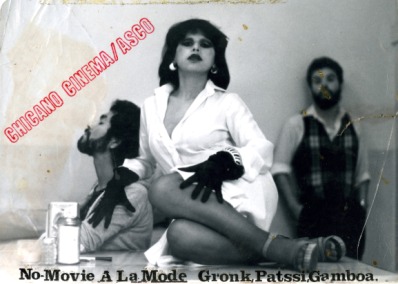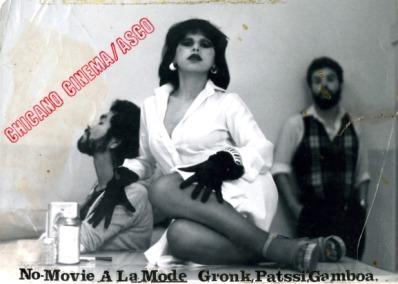Chismearte: What is a No-Movie?
Gamboa: It is perceiving life within a cinemagraphic context.
Gronk: It is thinking of life before the advent of a view finder. It is projecting the real by rejecting the reel.
—“Interview: Gronk and Gamboa,” originally published in Chismearte 1, no 1 (Fall 1976), reprinted in the exhibition catalogue for Asco: Elite of the Obscure, A Retrospective 1972-1987
As we usher in the last month of the exhibition Asco: Elite of the Obscure, A Retrospective 1972-1987, two of our upcoming exhibition-related public programs will focus on the role of movies—and "No Movies"—in Asco’s oeuvre. This Friday I will be joined by filmmaker and scholar Jesse Lerner for Asco: Chicano Cinema and Agnes Varda’s Mur Murs. The program is part of Filmforum’s Pacific Standard Time contribution, Alternative Projections: Experimental Film in Los Angeles 1945-1980, an incredible research project that has resulted in a vast archive of oral histories with Southern Californian filmmakers and artists as well as many film programs over the course of the next few months. (The second Asco event this month will be a conversation between Gronk and Marisela Norte on Asco & Cinema.)

Asco, Á La Mode, 1976, photograph by Harry Gamboa Jr., courtesy of the UCLA Chicano Studies Research Center (CSRC) Library, from the collection of Patssi Valdez, © 1976 Asco/Photograph Harry Gamboa Jr.
Asco blurred the lines of various media, merging performance, photography, muralism, and film. As was the case for many of the filmmakers presented in Alternative Projections, Asco lived in the shadow of Hollywood, feeding off of its productions but also striving to create a counter-vision out of their own lived realities. Asco’s invention of No Movies, or film stills for non-existent films, allowed the group to appropriate the spectacle of Hollywood even as they critiqued the absence of Chicanos in the mass media. The group did use film occasionally when they had access to Super 8 and 16 millimeter cameras, but their engagement with media was greatly enhanced with the advent of public access media and portable video equipment.
Also part of Friday's program is a screening of Agnes Varda's 1981 film Mur Murs. Varda came to Los Angeles to work a film essay that meditates on how muralism allowed the walls of Los Angeles’ barrios and working-class neighborhoods to speak and assert their identities. At Varda’s invitation, Asco created an ephemeral mural and took part in it simultaneous birthing and destruction ultimately realizing the group’s dreams of interjecting themselves into the glamorous and cool aesthetics of French New Wave.
Rita Gonzalez, associate curator, contemporary art



